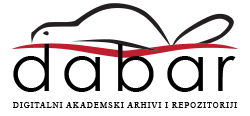| Abstract | Increasingly competitive business environments are the main driving forces for investment in the development of flexible and efficient information systems (IS). The success of IS development, implementation and maintenance influences the way business processes are managed and carried out, which consequently forces IS to evolve. Many factors affect the IS evolution strategy business process and IS re-engineering, based on auditing of an organisation’s information technology (IT) infrastructure. In this thesis we introduce a complex methodology for planning and implementing the auditing of IT infrastructures in order to develop an IS that fully supports strategic and business needs. The ISRQCC is a step-by-step methodology that can help you plan and implement an iterative process of Information Systems (IS) auditing within any stage of the development, implementation and maintenance of systems from various problem domains (businesses). Most organisations will be challenged to use their IS audit results in order to change their business operations, re-engineer their IS, or to re-schedule various tasks of project management plans, which could result in automating tasks that might have been performed manually in the past. Various solutions as a result of IS auditing process could be offered: from implementing new development paradigms and emerging technologies, to solutions that are based on legacy systems as a better balance between costs, benefits and risk. However, in all cases the ISRQCC will enable you to have a clearer idea of what your businesses’ and IT needs are, and will give you a clear list of all benefits of using different technologies for developing an IT infrastructure that supports its strategic business objectives. This might be of significance when knowing that only 26% of software projects succeed when developing IS. Hence the IS audit activities are becoming a very common intervention to ‘save’ them from failure.The ISRQCC concentrates on the project feasibility and on finding the set of possible solutions for the current and for the future project problems. Whereas, it can be also used for all the other audit measurement factors. |
| Abstract (croatian) | Osnovni i najvažniji razlog ulaganja u razvoju fleksibilnih i robustnih informacijskih sustava (IS), je sve veća poslovna konkurencija. Puno faktora utječe na poslovnu strategiju, evoluciju, održavanje i restrukturiranje IS; ti faktori mogu se ocijeniti,kontrolirati ipratiti (engleski audit) primjenom bazičnih kontrolnih ili audit operacija na informacijsku infrastrukturu odgovarajuće firme. Zahvaljujući višestrukoj iskoristivosti (engleski: reusability) postojećih komponenata IS-a i upotrebom objektno orijentiranih načela (paradigma), dijelovi, odnosno komponente PKRIS metode su uspješno primijenjeni i rezultati tih audit operacija su uspješno ugrađeni u različitim poslovnim domenama. PKRIS je postupna metoda koja može pomoći kod planiranja i ugradnje iterativnih postupaka praćenja IS-a; i to u bilo kojoj fazi razvoja, ugradnje i održavanja IS-a, te u različitim poslovnim domenama. Većina organizacija je ‘prisiljeno’ primijeniti rezultate postupaka praćenja na svojim informacijskim sustavima, da bi se poboljšali poslovni procesi, da bi se opravdalo restrukturiranje IS-a, ili za ponovno planiranje projekta. PKRIS metoda je namijenjena netehničkim auditorima, audit menedžerima, audit komitetima, poslovnim menedžerima, voditeljima projekata i direktorima. Audit operacija rezultira stablom odluka (engleski: decision tree) koje će pomoći audit menedžerima, voditeljima projekata, advokata i audit specijalista u procjeni vjerojatnosti uspjeha IS-a. PKRIS metoda nudi mogućnost predviđanja budućih problema u IS-u, a to rezultira promjenom plana projekta i ponudom skupa mogućih rješenja za lokalizirane izvore problema. PKRIS je kao postupna metoda praćenja zasnovana na Daytonovim radovima, i osobnim profesionalnim iskustvima, tako da omogućuje analize specifičnih poslovnih situacija. PKRIS metoda se koncentrira na faktor ‘izvodljivost (feasibility)’ IT projekta i na pronalaženje skupa mogućih rješenja za postojeće i buduće probleme u projektu. Metoda se može, međutim, isto tako primijeniti i na drugim faktorima. |

